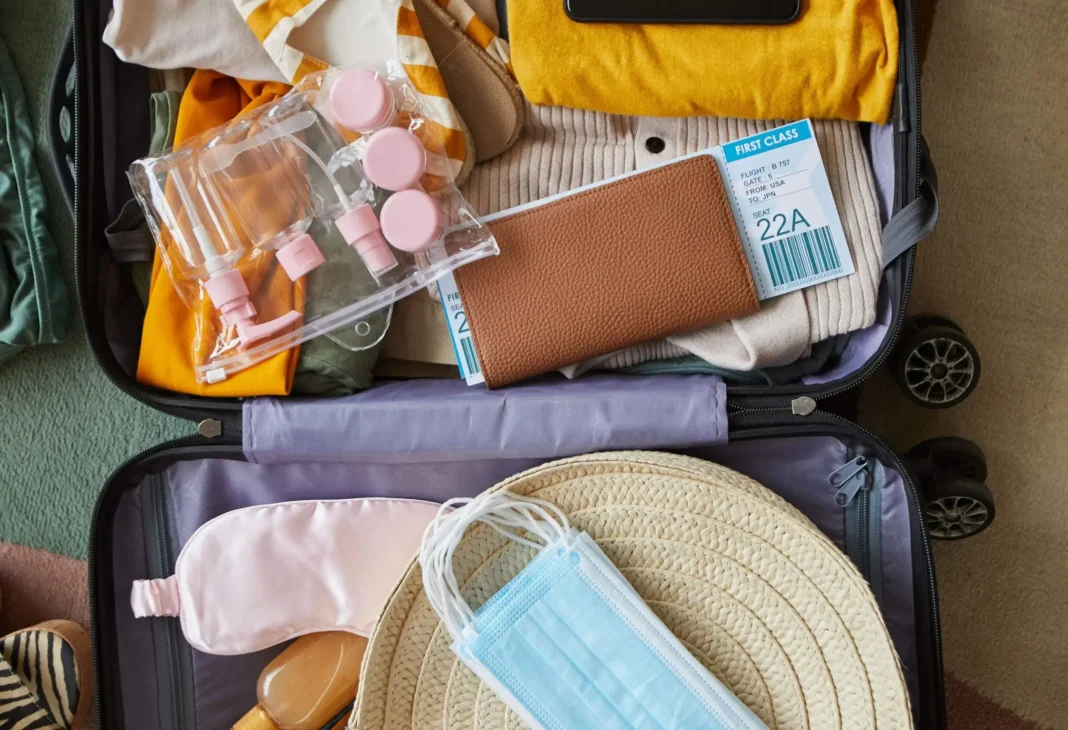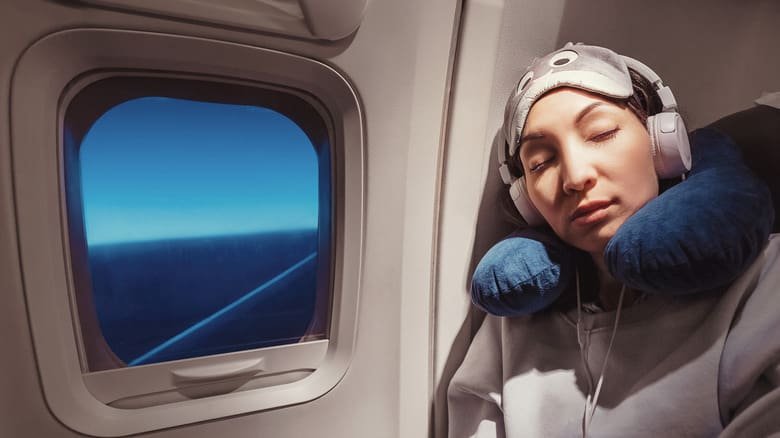Jet Lag Tips: Reset Your Clock Fast for Long-Haul Flights

Imagine stepping off a plane after a 12-hour flight from New York to Tokyo. Your body insists it’s still the middle of the night, even though the sun is blazing overhead. Coffee doesn’t work, your stomach is confused, and every blink feels heavy. If you’ve ever flown across multiple time zones, you know this feeling well. These are the moments when jet lag tips become essential to help your body adjust quickly and feel alert again.
In this guide, you’ll learn how to use light, movement, and meal timing to reset your body clock in as little as 48 hours.
Understanding Jet Lag and Your Circadian Rhythm
Before tackling jet lag, it’s essential to understand why it happens. Your body follows a roughly 24-hour internal clock, called the circadian rhythm, which regulates sleep, hormone production, appetite, and even body temperature. When you cross multiple time zones, your internal clock becomes misaligned with the local day-night cycle, leaving you feeling groggy, irritable, and physically out of sync. Common symptoms include:
- Difficulty falling asleep or waking at the right times
- Impaired cognitive performance and brain fog
- Digestive discomfort and appetite changes
- Mood fluctuations and fatigue
To visualize how jet lag works and what helps reset your body here’s a quick breakdown:
Jet Lag Symptoms vs. Recovery Lever
| Jet Lag Symptom | What Causes It (Circadian Disruption) | Recovery Lever That Helps |
|---|---|---|
| Trouble sleeping / waking | Melatonin and cortisol release out of sync | Light exposure at strategic times |
| Brain fog & slow focus | Sleep–wake cycle misaligned | Morning sunlight + movement |
| Digestive issues | Meal timing mismatched to new timezone | Eat meals at local times |
| Fatigue & low mood | Hormone rhythm shifted | Consistent sleep schedule + daylight |
| Midday energy crash | Circadian dip occurring at the “wrong” hour | Light activity + hydration |
Circadian rhythms are influenced by light exposure, meal timing, and physical activity. Research from Northwestern University, cited by UCLA Health, found that scheduling meals to match the local time zone can significantly help reset your body clock.
For instance, travelers flying from New York to Europe might have a light dinner before the flight, avoid eating during the flight, and enjoy a hearty breakfast upon arrival. Combined with deliberate exposure to bright daylight, this strategy can reduce the typical six-day recovery period by up to one-third.
Understanding these cues, light, movement, and meals, provides the foundation for a practical routine to reset your circadian rhythm efficiently.
Pre-Flight Preparation: Give Yourself a Head Start

Effective jet lag management begins before you even board the plane. Small adjustments can make a significant difference in how quickly your body adapts to a new time zone. According to experts, several actionable strategies can help:
1. Adjust Your Sleep Schedule Gradually
- Shift your bedtime and wake time by 30–60 minutes per day toward your destination’s schedule, starting a few days before departure.
- Example: Flying from New York to Tokyo? Go to bed an hour earlier each night, so your body slowly acclimates.
- MedlinePlus notes that “modifying your sleep schedule in the two days leading up to your trip can be beneficial so that when you arrive at your destination, there is less of a discrepancy between your circadian rhythm and the local time”.
2. Mind Your Meals
- Eat lighter, balanced meals before your flight and avoid heavy late-night eating.
- Limit alcohol and caffeine 6–8 hours before sleep, as both can interfere with your circadian rhythm. The source emphasizes that proper nutrition and timing can reduce jet lag effects.
3. Pack Smart
- Bring eye masks, noise-canceling headphones, neck pillows, and compression socks. These comforts reduce in-flight stress and help you rest.
4. Choose Flight Times Wisely
- If possible, book flights that align your sleep with the destination’s night, giving your body more time to adjust upon arrival.
By combining sleep adjustments, meal timing, and strategic planning, you can reduce the severity of jet lag and start your trip feeling more refreshed.
In-Flight Routine: Start Resetting Early

Long-haul flights are an opportunity to start resetting your body clock before you land. The CDC emphasizes that timing your activities according to your destination’s schedule can significantly reduce jet lag symptoms.
1. Sync Your Meals: Eat according to your destination’s time zone rather than your departure city. Even small adjustments in meal timing help signal your body about the new schedule.
2. Manage Light Exposure: Light is critical for circadian alignment. Bright light promotes alertness, while darkness triggers melatonin, your sleep hormone. Use sleep masks during your destination’s nighttime hours and seek cabin light during local daytime hours. The CDC notes that appropriately timed light exposure can decrease the duration of circadian desynchrony.
3. Move Frequently: Stand, stretch, or walk the aisle every 2–3 hours. Movement prevents stiffness, improves circulation, and helps your body stay alert when it’s daytime at your destination.
4. Strategic Napping: Keep naps short, 20–30 minutes to maintain alertness without interfering with nighttime sleep. Longer naps can hinder your body clock’s adjustment.
5. Hydrate and Avoid Excess Stimulants: Aim to drink about 250 ml (one cup) of water per hour of flight. Staying hydrated helps your body regulate temperature, circulation, and alertness. Avoid excess alcohol, caffeine, and long-acting sedatives, which can worsen jet lag symptoms and disrupt natural rhythms.
By following these in-flight strategies, you can start aligning your circadian rhythm with your destination, making the transition smoother once you arrive.
Post-Arrival Protocol: 48-Hour Body Clock Reset

Once you land, a focused 48-hour routine can dramatically reduce jet lag symptoms. According to the Mayo Clinic’s Jet Lag Disorder guide, the key is syncing light, meals, and sleep to your destination’s local time as soon as possible.
Example Timeline (For Reference)
Flight: Arrive 8:00 AM Tokyo time
9:00 AM – Sunlight: Go outside immediately for natural light exposure
10:00 AM – Breakfast: Eat a light, protein-forward meal at the local time
1:00 PM – Movement: Take a walk or do light exercise
10:00 PM – Sleep: Follow local bedtime even if you’re not fully sleepy yet
Use this as a template and adjust based on your arrival time.
Day 1
- Morning sunlight: Get at least 30–60 minutes of natural light exposure. Sunlight is the strongest cue for your circadian rhythm, helping your brain and hormones recognize it’s daytime.
- Meals: Eat at local mealtimes, even if you’re not hungry yet. This helps your body clock adjust more quickly to the new schedule.
- Movement: Do light exercise, walking, or stretching to reinforce wakefulness.
Day 2
- Keep getting morning sunlight to reinforce your new rhythm.
- Maintain consistent meal and sleep times.
- Light afternoon movement (a walk or easy workout) prevents mid-day crashes.
- Use caffeine strategically, limit intake to before 2 PM local time.
Extra Hacks
- Blue-light blocking glasses: Help reduce evening alertness so you can fall asleep earlier.
- Wearables: Devices like Oura or Fitbit can track your sleep and suggest optimal rest windows.
- Melatonin: As the Mayo Clinic notes, melatonin may help your body align with the new local time but only under medical advice.
Mayo Clinic emphasizes: “Because light is so crucial to your internal clock, you may be able to ease your adjustment to a new time zone by exposing yourself to daylight. Try to time your meals with local mealtimes too.”
Common Mistakes That Worsen Jet Lag

Even seasoned travelers fall into traps that delay recovery:
- Oversleeping or taking long naps: This confuses your circadian rhythm and delays adjustment to the new time zone.
- Ignoring light exposure: Staying indoors or using screens too long at night disrupts melatonin release, keeping your body “stuck” in its old rhythm.
- Eating at the wrong times: Your digestive system is tied to your internal clock. Off-schedule meals send mixed signals to your body, causing it to adapt harder.
By avoiding these, you make your 48-hour reset far more effective.
PRO TIP: Do’s vs. Don’ts for Faster Adjustment
DO:
- Get morning sunlight
- Eat at local mealtimes
- Use light movement to stay awake
- Keep bedtimes consistent
DON’T:
- Take long naps
- Stay indoors all day
- Eat according to your “old” time zone
- Use screens late into the night
Avoiding these habits accelerates recovery and keeps your body aligned with local time faster.
Bonus Tips for Frequent Flyers

Create a personal jet lag toolkit: eye mask, earplugs, travel pillow, and portable light device to make sleep and adaptation easier. As Stanford Lifestyle Medicine sleep physician Dr. Cheri D. Mah notes, having portable versions of your at-home sleep tools helps your brain associate travel sleep with familiarity, reducing adjustment stress.
Maintain a consistent sleep schedule even between trips. A stable circadian rhythm helps your body adapt faster when you cross time zones. Dr. Mah also recommends adjusting your bedtime before travel (earlier for eastward flights, later for westward) and getting light exposure at local morning hours to anchor your new rhythm.
For those who fly frequently especially weekly business travelers pre-trip micro-adjustments can make a dramatic difference. Even 15-minute shifts in sleep and light exposure in the days before departure can cut jet lag duration nearly in half, according to circadian rhythm researchers.
Frequent travelers can also experiment with strategic “split sleep”: dividing rest into two shorter cycles aligned with the destination’s night hours. When paired with melatonin (taken 30–60 minutes before local bedtime under medical guidance), this approach can accelerate clock realignment and significantly reduce fatigue.
Jet Lag Tips to Help You Feel Like Yourself Again

Jet lag doesn’t have to ruin the start of your travel plans. By understanding your circadian rhythm and following science-backed strategies, you can reduce grogginess, regain focus, and adjust to new time zones faster often in as little as 48 hours.
Key takeaways to reset faster:
- Shift your sleep schedule before flying to ease the travel transition.
- Use light and meals as your primary reset cues, aligning them with your destination.
- Stay hydrated and move frequently to keep travel fatigue low.
- Expect to feel normal again within 48 hours with a structured reset plan.
Next time you travel across multiple time zones, your recovery plan is already built in helping you land refreshed, energized, and ready to explore with zero wasted days.
FAQs About Jet Lag Tips
1. Does jet lag affect eastward and westward travel differently?
Yes. Traveling eastward (like from New York to Paris) tends to cause worse jet lag because you lose hours and must fall asleep earlier than usual. Westward travel (like from Tokyo to London) is easier since your day is lengthened, and your body naturally adjusts better to staying up later.
2. How long does jet lag usually last?
Most travelers recover at a rate of one day per time zone crossed, but this varies depending on factors like age, sleep quality, and how well you follow light and meal timing. Using targeted jet lag tips can shorten recovery to just two days for most people.
3. Are there apps that help track or prevent jet lag?
Yes! Tools like Timeshifter, Entrain, and Jet Lag Rooster use circadian science to suggest customized light exposure, sleep, and caffeine schedules based on your destination and flight details.
4. Does age affect how we experience jet lag?
It does. Older adults often experience more intense symptoms and take longer to recover, as circadian rhythms become less flexible with age. In contrast, younger travelers may bounce back faster, though inconsistent sleep habits can worsen their jet lag.
5. Can napping before a flight help prevent jet lag?
Only strategically. A short nap (20–30 minutes) before departure can reduce fatigue during red-eye flights, but long pre-flight naps may disrupt your ability to fall asleep at your destination’s nighttime.

